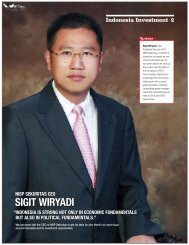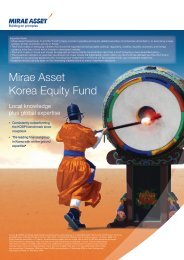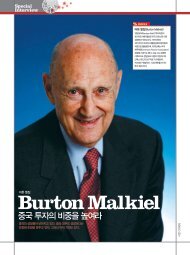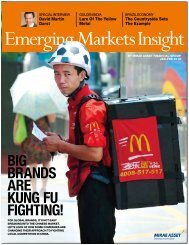asians drive the premium skin care market - Mirae Asset Global ...
asians drive the premium skin care market - Mirae Asset Global ...
asians drive the premium skin care market - Mirae Asset Global ...
Create successful ePaper yourself
Turn your PDF publications into a flip-book with our unique Google optimized e-Paper software.
Cosmetics, Asian RushASIANS DRIVETHE PREMIUMSKIN CAREMARKETAll roads lead to China. What's happening in <strong>the</strong>new frontier?By Ahn Sol (Reserch Analyst at <strong>Mirae</strong> <strong>Asset</strong> <strong>Global</strong> Investments(HK))Worldwide cosmetics sales have neverdeclined in <strong>the</strong> past 18 years, and <strong>the</strong>ir annualgrowth rate was 4.4% between 1993 and2011. From 2001 to 2011, <strong>the</strong> Chinese <strong>skin</strong>/cosmetics <strong>market</strong> has shown a 17.0% growthrate, and <strong>premium</strong> <strong>skin</strong>/cosmetics <strong>market</strong>has grown by an even faster rate of 22.3%.This is why China is often cited by cosmeticscompanies as a key <strong>market</strong> for growth. EstéeLauder, L’Oréal, Shiseido, Proctor &Gamble,etc. have been making substantial investmentsin <strong>the</strong> country over <strong>the</strong> past decade.Cosmetics <strong>market</strong> growth rates in Chinaare expected to decelerate compared to <strong>the</strong>past 10 years, but we believe <strong>the</strong> industry canEmerging Markets Insight 9
Cosmetics, Asian Rushstill continue to grow by doubledigits and even faster for<strong>premium</strong> cosmetics in <strong>the</strong>next five years. In additionto nominal GDPgrowth and populationgrowth,urbanization willbe <strong>the</strong> stronggrowth <strong>drive</strong>r ofcosmetics industry.Urbanizationis <strong>the</strong> top priorityof <strong>the</strong> new governmentin China. This isimportant becauseurbanization will not onlystimulate consumer adoption of<strong>skin</strong> <strong>care</strong> and color cosmetics but, also,urban households tend to earn higherincomes than rural households which enableconsumers to trade up to more discretionaryitems such as <strong>premium</strong> cosmetics products.China's AttractionEmerging <strong>market</strong> consumers need to reacha certain level of income or GDP per capitabefore adoption of consumer products begin.This adoption wave typically starts withhousehold products like detergents andsoaps, extends to packaged foods such asinstant noodles and <strong>the</strong>n moves up to relativelydiscretionary categories, which includemost personal <strong>care</strong> products. Skin <strong>care</strong> andcolor cosmetics are one of <strong>the</strong> later adoptioncategories, and deceleration occurs here generallymore slowly than o<strong>the</strong>r consumer products.Thus, cosmetics maintain faster growthrates for a longer period.China has grown to become <strong>the</strong> largest Asian<strong>market</strong> for two gigantic beauty players,namely L’Oréal and Estée Lauder. Chinaaccounts for 7% and 5% of L’Oréal’s andEstée Lauder’s total sales respectively. Andthis is purely sales from mainland China. Weassume Estée Lauder’s real sales fromChinese consumers to be around 15% of totalcompany sales, as Chinese consumers will bebuying Estée Lauder products in o<strong>the</strong>r placeslike Hong Kong, New York, and Paris. Accordingto Estée Lauder, every $1 spent in Chinaimplies an extra $2 in sales from Chinese outsideof China.The Chinese cosmetics industry trendfavors foreign luxury cosmetics players notonly because of its faster organic growth butalso because China (and Asia overall) is amore profitable <strong>market</strong>. The Asian cosmetics<strong>market</strong> is over-indexed to <strong>premium</strong> <strong>market</strong>s.In China, <strong>the</strong> <strong>premium</strong> <strong>skin</strong> <strong>care</strong> <strong>market</strong> hasgrown to 26% of <strong>the</strong> total <strong>skin</strong>-<strong>care</strong> <strong>market</strong>from 17% in 2001. Still, <strong>the</strong> <strong>premium</strong> <strong>market</strong>share is under-indexed to o<strong>the</strong>r Asian <strong>market</strong>s,thus we expect China’s <strong>premium</strong> <strong>market</strong>to continue to outgrow <strong>the</strong> overall industry.Premium <strong>skin</strong> <strong>care</strong> has a 72% <strong>market</strong>share in Hong Kong, 59% in Taiwan, 57% inSouth Korea, and 55% in Japan, whereas it isonly 20% in Germany, 30% in <strong>the</strong> US, 44% inCanada and 48% in France. We believe Chinawill follow <strong>the</strong> same path as o<strong>the</strong>r Asian countries.This is definitely a tailwind for global cosmeticsplayers who are well-positioned in <strong>the</strong>prestige and <strong>premium</strong> <strong>market</strong>.Asian <strong>market</strong>s including China tend to offerhigher returns for many global cosmeticsplayers. This is because Asians spend moreon <strong>skin</strong> <strong>care</strong> products that tend to have higherprice points. Also, it is easier for companies to<strong>premium</strong>ize <strong>skin</strong> <strong>care</strong> products with addedfunctions. There are more opportunities toadd values on <strong>skin</strong> <strong>care</strong> products with whitening,anti-aging, brightening, etc., compared tocolor cosmetics or fragrances. Skin <strong>care</strong>accounts for roughly 70% of <strong>the</strong> Chinesebeauty <strong>market</strong> whereas it is only 35% inNorth America, 32% in Brazil, or 37% inRussia. This is again an Asian phenomenon as<strong>skin</strong> <strong>care</strong> accounts for 62% of <strong>the</strong> beauty<strong>market</strong> in Japan, 64% in South Korea and62% in India. For Estée Lauder, <strong>skin</strong> <strong>care</strong>accounts for 60% in <strong>the</strong> Asia Pacific <strong>market</strong>Asian <strong>market</strong>s including China tend to offerhigher returnsfor many global cosmetics players.26.8 22.4 20.6Source : TrefisUnit : %(forecast)US200620112015EUROPEcompared to that of 43% for <strong>the</strong> group. InChina, specifically, 82% of sales were incurredfrom <strong>premium</strong> facial <strong>care</strong> and <strong>the</strong> rest from<strong>premium</strong> color cosmetics. Asian consumerstend to spend or invest more on <strong>skin</strong> <strong>care</strong>because of <strong>the</strong> increased cultural importanceof having well-maintained <strong>skin</strong>. A significant<strong>Global</strong> sales of Prestige cosmetics products37.3 36.1 33.44.4 5.1 5.8middle east, etc.JAPAN15.7 9.5 7.115.8 26.8 33.1Asia pacific (ex japan)Emerging Markets Insight 10
Cosmetics, Asian RushMNCs have stronger moatsin <strong>the</strong> household beauty andpersonal <strong>care</strong> (HPC) business.number of women are buying LV bags inChina, and we assume that <strong>the</strong>se samewomen would be more than happy to pay a<strong>premium</strong> for <strong>the</strong>ir beauty.The Men's MarketAno<strong>the</strong>r emerging trend in cosmetics is <strong>the</strong>fast-growing men’s grooming segment. In<strong>the</strong> past, it was almost taboo for Europeanmen to use <strong>skin</strong> <strong>care</strong> products, but this now ischanging. In fact, <strong>the</strong> popularity of <strong>the</strong> men’ssegment actually started in China. Accordingto <strong>the</strong> president of L’Oréal Asia, <strong>the</strong> companysaw a boom in men’s <strong>skin</strong> <strong>care</strong> in China andrealized <strong>the</strong> potential for <strong>the</strong> segment globally.It has become a larger <strong>market</strong> earlier in Asiabecause <strong>the</strong>re is no such taboo for Asian menand partly due to Asian climates, as <strong>skin</strong> <strong>care</strong>products are more of a necessity in someregions. Still, cosmetics is largely women’scategory globally, but if it can be extended tomen, <strong>the</strong>re will be ano<strong>the</strong>r strong demandpull for <strong>the</strong> whole industry.Local players in Asia are generally verystrong compared to those in o<strong>the</strong>r emerging<strong>market</strong>s. This is because many Asian countrieshave solid competitiveness in manufacturing,and local companies usually have betterdistribution networks. This is especiallytrue for food companies. Food is an indigenousproduct and locals better understand<strong>the</strong>ir region’s tastes. We believe, however,that multinational corporations (MNCs) havestronger moats in <strong>the</strong> household beauty andpersonal <strong>care</strong> (HPC) business especially whenit comes to luxury or high-end consumergoods because <strong>the</strong>n it becomes more of abrand game. <strong>Global</strong> cosmetics players wellunderstand such phenomena and thus investsignificantly in emerging <strong>market</strong>s.HPC is a purely brand business as a productitself is homogeneous and does not requiremuch localization unlike food. This provides aglobal HPC expenditureby category, 2011Total HPC:$925bnHome Care$142bn15%ConsumerHealth$198bn21%Hygiene$171bn19%Beauty &Personal Care$414bn45%Sources : Euromonitor, Bernstein analysisEmerging Markets Insight 11massive advantage to MNCs as <strong>the</strong>y can easilyleverage <strong>the</strong>ir global heritage brands intoemerging <strong>market</strong>s. Local companies inemerging <strong>market</strong>s may somehow—albeit thisis also a challenge—make a breakthrough tomanufacture a good quality product, but evenif <strong>the</strong>y do so, <strong>the</strong>y cannot build a brand storyin one day. Also, MNCs tend to have strongermuscles for heavy advertisement and R&D.Particularly for cosmetics, since brand is soimportant, it can also be seen as an advertisementand <strong>market</strong>ing battle. L’Oréal and EstéeLauder spend around 30% of <strong>the</strong>ir sales onadvertising and promotions.The “Lipstick Effect”The cosmetics <strong>market</strong> is about aspirationalbrands which provide natural moats to MNCswith many global brands. As emerging <strong>market</strong>consumers acquire higher pricing powerwith double-digit wage growth in China, consumptiontrade-up will increasingly benefitglobal cosmetics companies. Such characteristicsare evidenced by <strong>the</strong> top 12 Beauty andPersonal Care (B&PC) companies having amore-than 50% global <strong>market</strong> share comparedto that of only a 17% share for <strong>the</strong> top15 global food and beverage (F&B) companies.The prestige and <strong>premium</strong> cosmetics<strong>market</strong> will continue to be a game betweenonly a handful of global companies, just likeo<strong>the</strong>r luxury goods.Cosmetics is a unique category, havingboth staples and discretionary characteristics,and even luxury characteristics for prestige/<strong>premium</strong> cosmetics. It is a consumer staplebecause women (soon perhaps men as well)have to use cosmetics every day once <strong>the</strong>ystart using <strong>the</strong>m. At <strong>the</strong> same time, consumerstrade up to <strong>premium</strong> brands along with anincrease in discretionary income. In a recession,women tend to satisfy <strong>the</strong>ir luxurydemand with lower-ticket-price items andtypically <strong>the</strong>y buy prestige cosmetics. This is<strong>the</strong> so-called “lipstick effect.” Thus, cosmeticscategory growth is usually faster than o<strong>the</strong>rconsumer staples goods in a good economyand it also tends to be more defensive thanluxury goods growth in slow economy.
Cosmetics, Asian Rushpersonal-<strong>care</strong> <strong>market</strong>s over <strong>the</strong> past decade,and Estée Lauder CEO Fabrizio Freda hasdeclared his intent to make it <strong>the</strong> company’s“second home <strong>market</strong> .” While <strong>the</strong> globalbeauty <strong>market</strong> has grown by 5% annuallyover <strong>the</strong> past 10 years, <strong>the</strong> Chinese beauty<strong>market</strong> has expanded by 12% per annumover <strong>the</strong> same period. Prestige beauty hasproven to be a particularly dynamic segmentof <strong>the</strong> industry in China, growing in excess of20% each year.Skin<strong>care</strong> has been a key catalyst for prestigebeauty growth in China. Asian consumerstend to have more sophisticated <strong>skin</strong><strong>care</strong>regimes compared to <strong>the</strong>ir global counterparts.An Asian woman, on average, will useeight different <strong>skin</strong><strong>care</strong> products each day,including special products like whiteningcreams . A recent survey by China RealityResearch found that middle-class Chinesewomen are much more likely to trade up in<strong>the</strong>ir beauty regimen, ra<strong>the</strong>r than tradedown in order to save money. The Chineseconsumer is most aspirational in terms of<strong>skin</strong><strong>care</strong>, as an overwhelming 68% surveyedsaid <strong>the</strong>y would trade up compared to only2% planning to trade down.Fast-Growing Skin<strong>care</strong> MarketSkin<strong>care</strong> is a major strength for EstéeLauder, as it is <strong>the</strong> company’s most profitableand fastest-growing product segment. Assuch, <strong>the</strong> company has largely focused itsinnovation and advertising efforts in thisarea. In <strong>the</strong> fall of 2012, Estée launched aluxury <strong>skin</strong><strong>care</strong> line specifically targeting <strong>the</strong>local preferences of Chinese consumers, inhopes to fur<strong>the</strong>r penetrate <strong>the</strong> most important<strong>market</strong> for <strong>the</strong> category globally. Osiao,as <strong>the</strong> brand is known, was developed over afive-year period with dedicated R&D specialistsin Shanghai who extensively studied differenttypes of Asian <strong>skin</strong> and téd <strong>the</strong> producton several thousand women across <strong>the</strong>region. The company has ambitions forOsiao to become one of <strong>the</strong> major brands ofits Asian portfolio.A booming travel trend among emergingSales (Euro Million)3,5003,0002,5002,0001,5001,0005000Skin Care: Best Performing in Chinese Premium Category53% of Total2001Source : Euromonitor, UBS ReasearchSkin<strong>care</strong> Makeup Fragrances Hair etc.Estée Lauder is well-positionedto benefit from <strong>the</strong> seculartailwinds of <strong>the</strong> rising emerging<strong>market</strong> consumer.<strong>market</strong> consumers is yet ano<strong>the</strong>r growth<strong>drive</strong>r for <strong>the</strong> prestige cosmetics industry.Estée Lauder has been able to capitalize on<strong>the</strong> trend by shifting some of <strong>the</strong> focus awayfrom its traditional department store businessmodel toward faster-growing, moreprofitable channels, like travel retail.The company’s travel retail business hasbecome an especially important <strong>drive</strong>r ofearnings growth in recent years, as it hasemerged as a key beneficiary of increasedtravel rates in Asia. Over <strong>the</strong> past decade,Chinese outbound travel activity has grownby more than 20% each year and is anticipatedto rise by 15% annually over <strong>the</strong> nextdecade to more than 100 million people .While traveling, consumers have anincreased proclivity to shop, whe<strong>the</strong>r in airportretail or downtown stores. And brands63% of Total2011with strong recognition in <strong>the</strong>ir home <strong>market</strong>are more likely to be purchased by consumerswhen traveling abroad. Because of this,increased travel trends largely benefit multinationalcosmetics companies with strongbrand equity, like Estée Lauder. The companyrecently cited that for every $1 worth ofcosmetics sold in China, it is able to generate$2 abroad from Chinese consumers . Astravel retail trends continue to grow, EstéeLauder’s sales figures should follow closely inline.Estée Lauder offers a sustainable competitiveadvantage over its peers operating in<strong>the</strong> personal <strong>care</strong> industry due to its pureplayexposure to <strong>the</strong> prestige beauty <strong>market</strong>,strong geographic footprint in emergingeconomies, and increased focus on highgrowth,high-margin product categories andretail channels. The company is well-positionedto benefit from <strong>the</strong> secular tailwinds of<strong>the</strong> rising emerging <strong>market</strong> consumer, and itcontinues to invest more heavily in <strong>the</strong> businessto gain <strong>market</strong> share globally.We believe this is one of <strong>the</strong> strongestglobal growth stories taking place in <strong>the</strong><strong>market</strong> today and will be following <strong>the</strong> companyclosely in years to come.Emerging Markets Insight 13
Cosmetics, Asian RushL´ORÉALDreams of OneBillion NewConsumersAs L’Oréal operates in categories across<strong>the</strong> beauty spectrum, <strong>the</strong> company is ableto reach more consumers relative to itscompetitors and retain dominant <strong>market</strong>sharepositioning.By <strong>Mirae</strong> <strong>Asset</strong> US research teamL’Oréal is a global beauty powerhouse.With $26 billion in annual sales last year, <strong>the</strong>company enjoys a commanding <strong>market</strong>share advantage over its competitors in <strong>the</strong>home and personal <strong>care</strong> industry, such asProctor & Gamble, Unilever, and EstéeLauder. The company boasts a broad presenceglobally, with operations in 130 countriesacross 27 international brands.Over <strong>the</strong> next decade, <strong>the</strong> company is targetingone billion new customers. Seculargrowth trends in <strong>the</strong> global personal <strong>care</strong>industry, increased investments in innovationand <strong>market</strong>ing efforts and a focus ongrowth <strong>market</strong>s and categories shouldenable L’Oréal to reach this goal. Home andpersonal <strong>care</strong> is an $820 billion global industrywith a projected annual growth rate of6.4% through 2020, up from 5.1% from2001-2011. Emerging economies of Asia and<strong>the</strong> Middle East/Africa are expected to <strong>drive</strong>60% and 27% of this growth, respectively.As <strong>the</strong>se countries develop and <strong>the</strong>ir consumptionlevels converge with those of moremature <strong>market</strong>s, it is estimated <strong>the</strong> industrycould be six times as large—nearly $5 trillionglobally. Personal <strong>care</strong> currently accounts fornearly half of <strong>the</strong> industry’s sales and has <strong>the</strong>highest expected growth rate among all subsegments,with beauty products emergingas a clear winner .L’Oréal is expected to benefit from <strong>the</strong>global growth of <strong>the</strong> home and personal <strong>care</strong>industry. Revenue growth of personal <strong>care</strong>companies correlates highly to increasingincome and consumption levels in emerging<strong>market</strong>s.<strong>Global</strong> ReachTherefore, exposure to growth is largelydetermined by a company’s geographic footprint.In 2012, emerging <strong>market</strong>s accountedfor almost 40% of L’Oréal’s total sales, with agrowth rate of nearly 10% on a year-overyearbasis. Asia Pacific and Middle East/Emerging Markets Insight 14
Cosmetics, Asian RushAfrica regions made up more than 60% oftotal emerging-<strong>market</strong> revenue. And <strong>the</strong>company anticipates 75% of its futuregrowth to come from <strong>the</strong> developing world .As a result, locally relevant innovation,increased manufacturing capacity, and abroad retail presence in <strong>the</strong>se regions havebecome strategic pillars for L’Oréal.One of <strong>the</strong> company’s core beliefs is thatbeauty is founded in technology. As such,L’Oréal invests heavily in R&D initiatives tobolster its innovation pipeline. Research hubshave been established in all major geographiesin order to study local <strong>market</strong>s anddevelop formulas that meet <strong>the</strong> preferencesNorthAmerica25.0%L’Oréal global sales (2012) and research centersL’Oréal has 6 regional hubs, 19 reasearch centers and 16 valuationcenters for R&D.35.6%EuropeNew Markets39.4%Source : L’OréalBy offering products at variedprice points, L’Oréal appeals toa broader consumerbase than its competitors.Unit : %14Annual Growth Rate12<strong>Global</strong> Beauty IndustryL’Oréalof <strong>the</strong> specific consumer base. L’Oréal hasalso been at <strong>the</strong> forefront of developing andpatenting molecules used in <strong>the</strong>ir anti-agingproducts. The United Nations has citedunprecedented and pervasive aging trendsacross <strong>the</strong> global population in <strong>the</strong> 21st century,with no parallel in human history .Aging demographics, coupled with boomingconsumption trends in <strong>the</strong> personal <strong>care</strong>industry, should lead to a sustained increasein demand for anti-aging beauty products,both in developed and developing <strong>market</strong>s.While Estée Lauder competes strongly in <strong>the</strong>prestige segment of this category, L’Oréal’srobust innovation platform should help <strong>the</strong>company to gain fur<strong>the</strong>r share in <strong>the</strong> prestigeand mass <strong>market</strong>s globally.Everything and EverywhereThe depth and breadth of L’Oréal’s productportfolio offers yet ano<strong>the</strong>r competitiveadvantage over its industry peers. The companyoperates in mass, luxury, salon, cosmeceutical,and natural beauty categories.1086420-2 2002 2004 2006 2008 2010 2012Source : L’OréalBy offering products at varied price points fastest-growing <strong>market</strong>s and categories willacross a wide range of distribution channels, <strong>drive</strong> L’Oréal’s success in years to come. TheL’Oréal appeals to a broader consumer base company will be a major beneficiary of seculartailwinds from rising emerging <strong>market</strong>than its competitors. Employing a differentiatedproduct strategy, in conjunction with consumption trends, particularly in <strong>the</strong> personal<strong>care</strong> industry, and will retain dominanthigh levels of <strong>market</strong>ing and R&D spend, hasenabled L’Oréal to consistently outpace <strong>the</strong> <strong>market</strong> share positioning through a robustgrowth of <strong>the</strong> global beauty industry .innovation pipeline and strong <strong>market</strong>ingL’Oréal has emerged as <strong>the</strong> leader in globalbeauty. A continued focus on <strong>the</strong> world’s future looks bright forplatform. One billion consumers agree: <strong>the</strong>L’Oréal.Emerging Markets Insight 15






